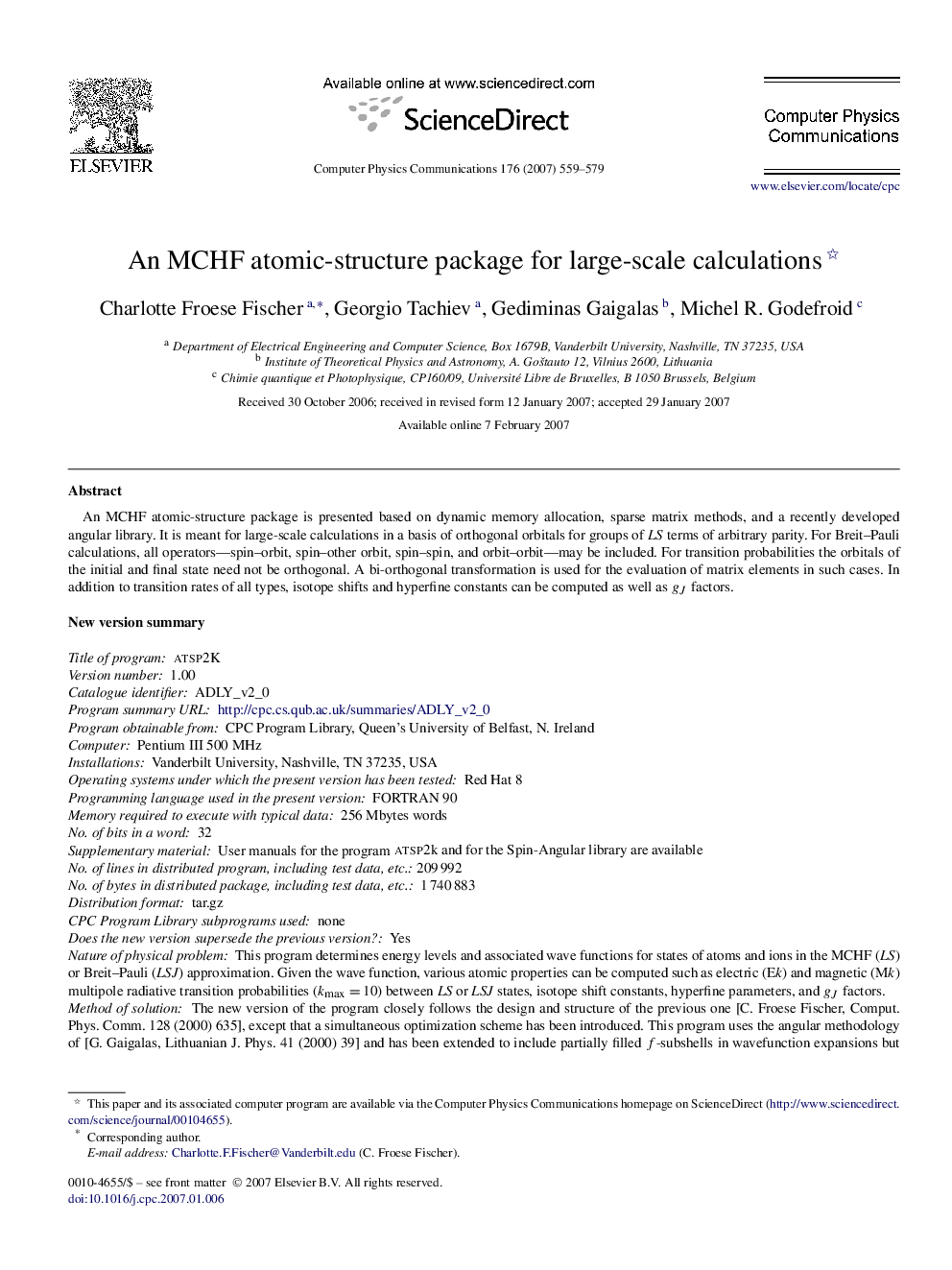| کد مقاله | کد نشریه | سال انتشار | مقاله انگلیسی | نسخه تمام متن |
|---|---|---|---|---|
| 503457 | 863768 | 2007 | 21 صفحه PDF | دانلود رایگان |

An MCHF atomic-structure package is presented based on dynamic memory allocation, sparse matrix methods, and a recently developed angular library. It is meant for large-scale calculations in a basis of orthogonal orbitals for groups of LS terms of arbitrary parity. For Breit–Pauli calculations, all operators—spin–orbit, spin–other orbit, spin–spin, and orbit–orbit—may be included. For transition probabilities the orbitals of the initial and final state need not be orthogonal. A bi-orthogonal transformation is used for the evaluation of matrix elements in such cases. In addition to transition rates of all types, isotope shifts and hyperfine constants can be computed as well as gJgJ factors.New version summaryTitle of program:atsp2KVersion number: 1.00Catalogue identifier: ADLY_v2_0Program summary URL:http://cpc.cs.qub.ac.uk/summaries/ADLY_v2_0Program obtainable from: CPC Program Library, Queen's University of Belfast, N. IrelandComputer: Pentium III 500 MHzInstallations: Vanderbilt University, Nashville, TN 37235, USAOperating systems under which the present version has been tested: Red Hat 8Programming language used in the present version: FORTRAN 90Memory required to execute with typical data: 256 Mbytes wordsNo. of bits in a word: 32Supplementary material: User manuals for the program atsp2k and for the Spin-Angular library are availableNo. of lines in distributed program, including test data, etc.:209 992No. of bytes in distributed package, including test data, etc.: 1 740 883Distribution format: tar.gzCPC Program Library subprograms used: noneDoes the new version supersede the previous version?: YesNature of physical problem: This program determines energy levels and associated wave functions for states of atoms and ions in the MCHF (LS) or Breit–Pauli (LSJ) approximation. Given the wave function, various atomic properties can be computed such as electric (Ek) and magnetic (Mk ) multipole radiative transition probabilities (kmax=10kmax=10) between LS or LSJ states, isotope shift constants, hyperfine parameters, and gJgJ factors.Method of solution: The new version of the program closely follows the design and structure of the previous one [C. Froese Fischer, Comput. Phys. Comm. 128 (2000) 635], except that a simultaneous optimization scheme has been introduced. This program uses the angular methodology of [G. Gaigalas, Lithuanian J. Phys. 41 (2000) 39] and has been extended to include partially filled f-subshells in wavefunction expansions but assumes all orbitals are orthonormal. The bi-orthogonal transformation method is used to deal with the non-orthogonality of orbitals between initial and final states of an electromagnetic radiative transition.Reasons for new version: The previous version of the MCHF atomic structure package [C. Froese Fischer, Comput. Phys. Comm. 128 (2000) 635] was intended for small calculations, ideal for someone not familiar with the code, producing extensive print-out of intermediate results. The codes for the calculation of spin-angular coefficients were often not the most efficient and could only treat configurations with open f-subshells containing at most two electrons or an almost filled shell with one hole. The present version is designed for large-scale computation using algorithms for angular integration that have been shown to be faster, and include the case of arbitrarily filled f-shells. In addition, the MCHF program has been modified to include optimization on an energy functional that is a weighted average of energy functionals for expansions of wavefunctions for different LS terms or parity, thus facilitating Breit–Pauli calculations for complex atomic systems and for computing targets in collision calculations.Summary of revisions: Programs have been modified to take advantage of the newly developed angular library [G. Gaigalas, Lithuanian J. Phys. 41 (2000) 39], extended to arbitrarily filled f-shells. New programs have been developed for simultaneous optimization and for the efficient calculation of atomic spectra and transition rates for an iso-electronic sequence. All applications now take advantage of dynamic memory allocation and sparse matrix methods.Restrictions on the complexity of the problem: All orbitals in a wave function expansion are assumed to be orthonormal. Configuration states are restricted to at most eight (8) subshells in addition to the closed shells common to all configuration states. The maximum size is limited by the available memory and disk space.Typical running time: Included with the code are scripts for calculating E2 and M1 transitions between levels of 3s23p23s23p2 for Si and P+P+. This calculation has two stages: LS and LSJ. The calculation of the former required 21 minutes for the LS calculation and 36.5 minutes for the Breit–Pauli configuration interaction calculation that determines the mixing of the terms.Unusual features of the program: The programming style is essentially F77 with extensions for the POINTER data type and associated memory allocation. These have been available on workstations for more than a decade but their implementations are compiler dependent. The present serial code has been installed and tested extensively using both the Portland Group, pgf90, compiler and the IBM SP2, xlf90, compiler. The former is compatible also with the Intel Fortran90 compiler. The MPI codes are included for completeness though testing has not been as extensive.Additional comments: Parallel versions (MPI) of the following programs are included in the distribution. Use of these is optional but can speed up the angular integration processing. SerialParallelnonhnonh_mpimchfmchf_mpibp_ang, bp_mat, bp_eivbp_ang_mpi, bp_mat_ang, bp_eiv_mpibiotr_ang, biotr_trbiotr_ang_mpi, biotr_tr_mpiFull-size tableTable optionsView in workspaceDownload as CSV
Journal: Computer Physics Communications - Volume 176, Issue 8, 15 April 2007, Pages 559–579